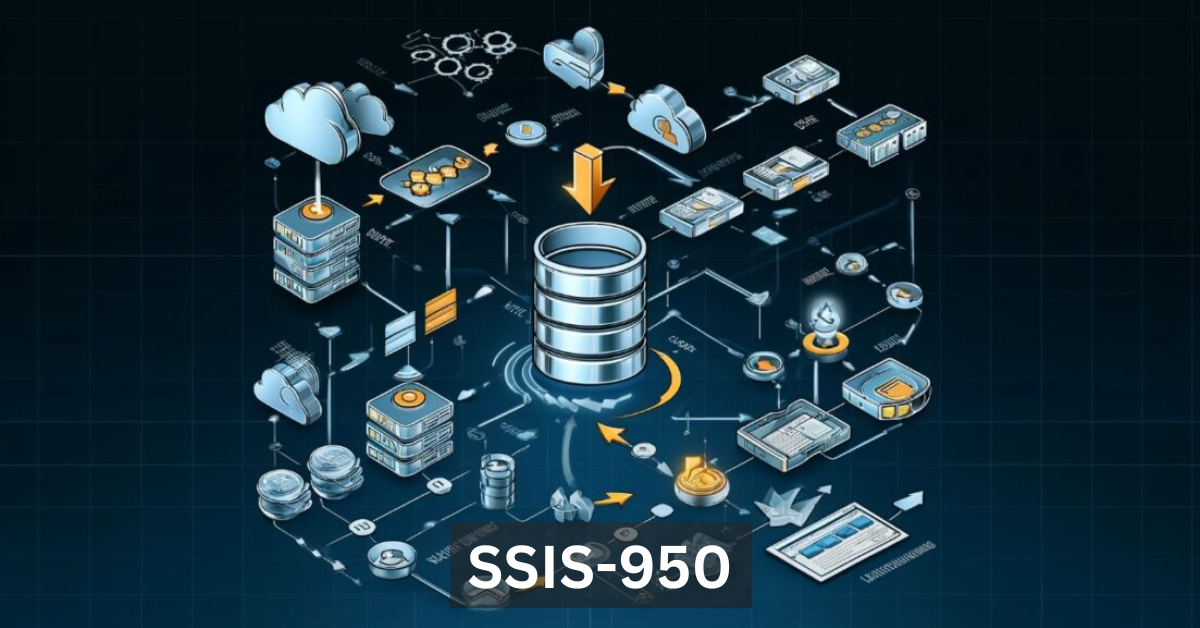SSIS-950: Unlocking the Future of Data Integration
In today’s data-driven world, effective data management is paramount for organizations striving to maintain a competitive edge. SQL Server Integration Services (SSIS), a robust platform from Microsoft, plays a crucial role in this landscape. SSIS-950 is a significant advancement in this domain, enhancing the capabilities of data integration and transformation.
SQL Server Integration Services is a component of Microsoft SQL Server designed for data integration and workflow applications. It provides a powerful platform for building data transformation solutions. Organizations leverage SSIS to create data pipelines that efficiently move data between various sources, transform it for analysis, and load it into target systems like data warehouses.
With the rise of big data, cloud computing, and advanced analytics, the need for effective data integration tools has never been greater. SSIS-950 stands out by incorporating enhancements that enable businesses to streamline their data workflows, improve data quality management, and facilitate seamless cloud integration. This evolution supports organizations in making informed decisions based on reliable data.
What is SSIS-950?
Definition and Context
SSIS-950 refers to a specific version of SQL Server Integration Services that incorporates critical updates and features designed to optimize data integration processes. This iteration builds upon the foundational elements of SSIS while integrating modern capabilities tailored to meet contemporary data demands.
Key Features and Capabilities
SSIS-950 offers several key features, including enhanced data processing efficiency, improved error handling, and advanced data transformation tools. These capabilities empower data engineers and ETL developers to design robust ETL (Extract, Transform, Load) processes that adapt to diverse data environments, whether on-premises or in the cloud.
The Evolution of SSIS and SSIS-950
Historical Context of SSIS Development
Since its inception, SSIS has undergone several transformations. Initially launched as a tool for data migration and simple ETL tasks, it has evolved into a comprehensive data integration platform. With each new version, Microsoft has added functionality to address the changing needs of data architects and analysts.
Major Milestones Leading to SSIS-950
The journey to SSIS-950 includes significant milestones, such as the integration of cloud capabilities and enhancements in performance tuning. The introduction of SQL Server 2017 marked a pivotal point, as it allowed SSIS to function more seamlessly with Azure services, thus enhancing its role in hybrid data environments.
Key Improvements in SSIS-950
Performance Optimization
One of the standout features of SSIS-950 is its performance optimization. The platform incorporates enhancements that allow for more efficient data processing, enabling organizations to handle larger volumes of data with greater speed. This improvement is crucial for businesses that rely on real-time analytics and need to process data quickly to make timely decisions.
Cloud Integration Capabilities
SSIS-950 excels in cloud integration, particularly with Azure. By leveraging Azure Data Lake and other Azure services, organizations can integrate their on-premises data with cloud resources seamlessly. This capability not only enhances flexibility but also supports the growing trend of cloud adoption in data management.
Advanced-Data Transformation Tools
Another hallmark of SSIS-950 is its advanced data transformation tools. The new features allow ETL developers to implement complex transformations with ease, improving the overall quality of the data being processed. This capability ensures that data analysts receive clean, accurate data that enhances their analytics solutions.
The Role of SSIS-950 in ETL Processes
Overview of ETL (Extract, Transform, Load)
ETL is a critical process in data management that involves extracting data from various sources, transforming it to fit operational needs, and loading it into target databases or data warehouses. SSIS-950 provides a user-friendly interface for designing and managing these workflows, enabling efficient data pipelines.
Extracting Data
In the extraction phase, SSIS-950 connects to diverse data sources, whether they are relational databases, flat files, or cloud-based data services. This versatility ensures that organizations can pull in data from multiple origins, creating a comprehensive view of their operational landscape.
Transforming Data
Once the data is extracted, SSIS-950 allows for intricate transformations. Data cleansing, aggregation, and manipulation techniques are integral to this phase, ensuring that the data is suitable for analysis. By implementing effective data quality management strategies during transformation, businesses can significantly improve the accuracy of their insights.
Loading Data
The loading phase is where transformed data is placed into target systems. SSIS-950 facilitates best practices for loading data, ensuring that it is done efficiently and securely. This capability is crucial for organizations that need to maintain the integrity and performance of their data systems.
Comparative Analysis: SSIS-950 vs. Previous Versions
Differences from SSIS 2016 and Earlier Versions
Compared to SSIS 2016 and earlier versions, SSIS-950 offers substantial improvements in performance and user experience. The interface has been streamlined, making it more intuitive for data engineers and ETL developers to create complex workflows. Additionally, enhancements in parallel processing allow for faster execution of ETL tasks.
Performance Metrics and Improvements
Performance metrics reveal that SSIS-950 handles larger data sets more effectively, reducing the time required for data integration tasks. These improvements contribute to overall data processing efficiency, a critical factor for organizations that depend on timely access to data.
Real-World Applications of SSIS-950
Case Studies Across Various Industries
Organizations across different industries have adopted SSIS-950 to enhance their data integration capabilities. For example, in the healthcare sector, data engineers utilize SSIS-950 to consolidate patient records from multiple systems, improving patient care and data accuracy.
Examples of Successful Implementations
Successful implementations of SSIS-950 are evident in the retail and finance sectors as well. Retailers leverage the platform to analyze customer data, enabling personalized marketing strategies. Financial institutions use SSIS-950 for risk management by aggregating data from various sources to enhance decision-making.
Best Practices for Using SSIS-950
Tips for Maximizing the Tool’s Capabilities
To maximize the benefits of SSIS-950, organizations should invest time in training data engineers and ETL developers on the latest features. Utilizing performance-tuning techniques can significantly enhance the speed and reliability of ETL processes.
Common Pitfalls to Avoid
While SSIS-950 is a powerful tool, common pitfalls include neglecting data quality checks and underestimating the importance of error handling. Establishing robust data governance practices can help mitigate these risks and ensure a smooth data integration process.
Common Challenges and Solutions with SSIS-950
Typical Issues Faced by Users
Users often encounter challenges related to data source connectivity, particularly when integrating legacy systems. These challenges can lead to delays and inaccuracies in data processing.
Troubleshooting Strategies
To overcome these challenges, implementing effective troubleshooting strategies is essential. Regularly updating SSIS-950 to the latest version can resolve connectivity issues and improve overall performance. Additionally, leveraging community forums and Microsoft’s support can provide valuable insights into common problems.
Future of Data Integration with SSIS-950
Trends and Predictions for Upcoming Features
The future of SSIS-950 looks promising, with ongoing advancements expected to enhance its capabilities further. Predictions indicate increased integration with artificial intelligence and machine learning tools, enabling automated data processing and enhanced analytics solutions.
The Role of SSIS-950 in Evolving Data Landscapes
As organizations continue to evolve in their data practices, SSIS-950 will play a pivotal role in facilitating data integration across hybrid environments. Its ability to seamlessly connect on-premises solutions with cloud services positions it as a leader in the future of data management.
Conclusion
SSIS-950 represents a significant leap forward in data integration technology, offering robust capabilities that address the evolving needs of organizations. Its performance optimizations, cloud integration, and advanced transformation tools make it an essential asset for data professionals.
For organizations looking to enhance their data management practices, adopting SSIS-950 is a strategic move. By investing in this powerful tool, companies can streamline their data workflows, improve data quality, and ultimately drive better business outcomes.
Frequently Asked Questions
What are the key features of SSIS-950?
SSIS-950 offers enhanced performance, cloud integration with Azure, and advanced data transformation tools.
How does SSIS-950 compare to previous versions?
It features improved performance metrics, a more intuitive interface, and better support for large data sets.
What industries benefit from SSIS-950?
Industries such as healthcare, retail, and finance have successfully implemented SSIS-950 for various data integration tasks.
What are the common challenges faced when using SSIS-950?
Users often encounter data source connectivity issues and may struggle with error handling.
What best practices should organizations follow when using SSIS-950?
Organizations should prioritize data quality management, performance tuning, and regular training for their data teams.
Stay in touch to get more updates & alerts on UnFite! Thank you






